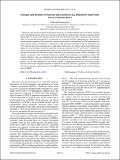Energies and lifetimes of electrons and excitons in Si20 modeled by many-body Green’s function theory
Author(s)
He, Yi; Zeng, Taofang
DownloadHe-2011-Energies and lifetimes of electrons.pdf (810.1Kb)
PUBLISHER_POLICY
Publisher Policy
Article is made available in accordance with the publisher's policy and may be subject to US copyright law. Please refer to the publisher's site for terms of use.
Terms of use
Metadata
Show full item recordAbstract
Electronic and excitonic properties in the silicon cluster Si[subscript 20] are studied using the many-body Green’s function theory. The implementations of the self-consistencies of both the one-particle Green’s function G and the reducible polarizability Π are discussed. Numerical results of the full self-consistency (FSC) and partial self-consistency (PSC) of the reducible polarizability Π are presented. It is found that the FSC implementation, where both the energies and the amplitudes of Π are updated, is numerically unstable. On the other hand, the PSC implementation, where only the energies are updated, is a stable process. The quasiparticle lifetimes in Si[subscript 20] are calculated by the GWΓ method and can be categorized into a high-energy regime and a low-energy regime. In the high-energy regime, the scaled lifetimes of electrons and holes in Si[subscript 20] are calculated to be 104 and 30 fs eV[superscript 2], respectively, which are close to the corresponding bulk theoretical values in the literature. In the low-energy regime, the scaled quasiparticle lifetimes are found to be longer than those in the high-energy regime, which is attributed to the absence of electronic states around the Fermi level available for the transitions of hot electrons (holes). The excitonic lifetimes in Si[subscript 20] are calculated using the dynamic Bethe-Salpeter equation (DBSE). It is found that excitonic lifetimes in a prolate structure such as Si[subscript 20] are irrelevant to the polarization direction of the incident photons, and are solely dependent on the excitonic energies. An approximate method for calculating excitonic lifetimes based on the weighted summation of lifetimes of electrons and holes is proposed. It is demonstrated that with a much less computational cost than DBSE, the approximation can produce results closely following those of DBSE.
Date issued
2011-10Department
Massachusetts Institute of Technology. Department of Mechanical EngineeringJournal
Physical Review B
Publisher
American Physical Society (APS)
Citation
He, Yi, and Taofang Zeng. “Energies and Lifetimes of Electrons and Excitons in Si_{20} Modeled by Many-body Green’s Function Theory.” Physical Review B 84.16 (2011): n. pag. Web. 17 Feb. 2012. © 2011 American Physical Society
Version: Final published version
ISSN
1098-0121
1550-235X